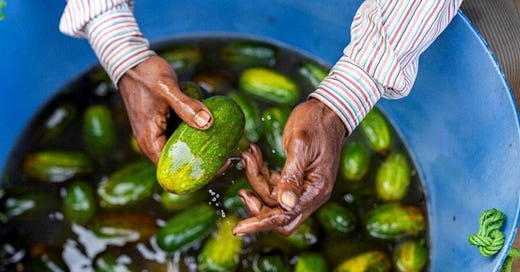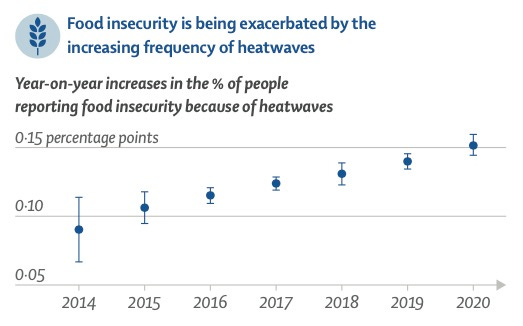An astonishing 258 million people face acute food insecurity, according to the World Food Program. This is hunger so severe that it poses an immediate threat to people’s livelihoods and lives. In other words, many people, who are mostly from Afghanistan, the Democratic Republic of the Congo, Ethiopia, parts of Nigeria, and Yemen, are on the brink of starvation.
This is an increase of 60 million people compared to 2021.
Extreme weather, water scarcity, plateauing crop yields, soil degradation and conflicts, such as the war in Ukraine, are the main causes.
FAO Food Price Index is down from its peak in 2022 but still 40% higher than two years ago. (The Index measures the monthly change in international prices of cereals, vegetable oils, sugar, meat, and dairy products.)
And now consider that in just seven years, the global population is expected to increase by 700 million.
Need-to-Know: Studies and reports about future food production are unrealistic
Incredibly, global reports and scientific articles on how climate change will affect food security are overly optimistic.
According to a recent Harvard University analysis projections of future-food production do not include many important variables such as:
Declines in pollinating insects are already limiting yields of fruits, vegetables, nuts, and legumes.
Greater heat in a warming climate decreases crop yields in the mid-latitude by damaging pollen preventing fertilization, reducing plant growth and increasing mortality. For example, a 1-degree-C increase in temperatures reduces rice, wheat and maize crop yields in India, Brazil, sub-Saharan Africa and other less-developed countries.
Livestock also suffer under heat stress which decreases fertility, weight gain, and milk and egg production.
Frequency of extreme events, like floods and droughts, and when and where they may occur.
Higher CO2 levels may increase crop growth but can also reduce their nutrient levels.
Increased pest and disease prevalence.
The impacts of biodiversity losses, including declines in pest predators, and in microorganisms are essential in maintaining soil fertility.
Fisheries declines as fish populations move towards the poles to avoid hotter ocean temperatures in tropics
Salinization of water tables caused by sea-level rise
Most of this laundry list of very-bad things can individually have a severe-to-moderate effect on agricultural production, according to the Harvard analysis.
Not good.
Welcome to Need to Know: Science & Insight, my personal newsletter that looks at what we Need-to-Know at this time of pandemic, climate emergency and unraveling of nature’s life supportsNeed-to-Know: World’s breadbaskets may fail in coming decade
The latest crop models that do incorporate some climate impacts such as hotter temperatures and increased extreme weather show substantial climate impacts coming well before 2040 in major breadbasket regions of the world.
We’ve already had a taste of this in recent years with extreme weather events in Europe, the U.S., China, Pakistan and elsewhere.
WHAT TO DO
Cut emissions as fast as possible.
Agriculture is not only highly vulnerable to the impacts of climate change but it is also a major source of carbon emissions. AG emissions need to fall nearly 40% as part of the global effort to help keep warming below 2 degrees C AND still feed the world’s growing population.
A few things that need to change to reduce impacts of food production and be able to feed people:
Dietary Adjustment — less meat on the menu.
If 54 high-income nations adopted the EAT-Lancet diet—a primarily plant-based diet—they could cut their emissions from food by nearly two-thirds, according to a study published in Nature Food.
This would also free up hundreds of billions of hectares of land currently used to feed livestock.
Embrace Alternative Proteins.
Alternative-proteins include cellular foods and precision fermentation. Meat, eggs, dairy grown in fermentation tanks could reach cost parity with those from animals by 2025, and be up to five times cheaper by 2030, according some reports.
The Impossible Burger and Beyond Meat are two examples. They have their drawbacks, for example, both are high in saturated fats. However, they are among the first attempts at alternative proteins. There is much more to come which I hope to talk about in a future issue.
Protect Soil and Water Resources with Regenerative Agriculture
Regenerative or ecological agriculture prioritizes soil health in terms of its carbon content and biodiversity. Through the use of practices like cover cropping, nutrient management, reduced or no tillage along with crop rotation, soil is improved, carbon captured, erosion and chemical-fertilizer use reduced.
Reduce Food Waste
About 17% of global food production is wasted, according to the UN Environment Programme’s (UNEP) Food Waste Index Report 2021.
By weight, food waste roughly equals that of 23 million fully loaded 40-tonne trucks — bumper-to-bumper, enough to circle the Earth 7 times.
About 61% of food waste happens in households, 26% from food service and 13% from retail.
NOTE: The UNEP report did not look at food waste from agricultural production including farms, transportation and food processing. When those sectors are included, the amount of wasted food nearly doubles to 32%.
Fairer Trade Agreements
Strengthening and broadening international trade agreements so that countries don’t impose food export restrictions during crises. The creation of multinational grain storage reserves would allow for a freer flow of food during lean years.
Finally, we also need stronger social safety nets to protect vulnerable populations from hunger, concluded the Harvard University analysis.
There are other aspects to this enormous subject of agriculture, food and hunger in a time of climate change. But this issue is already quite long. Let me know if there is something you’d like to see in a future issue.
Until next time, be well.
Stephen






